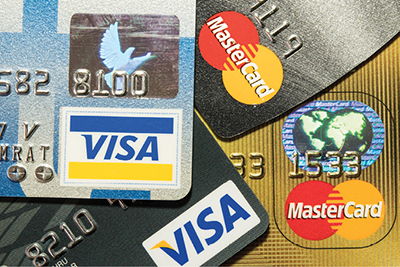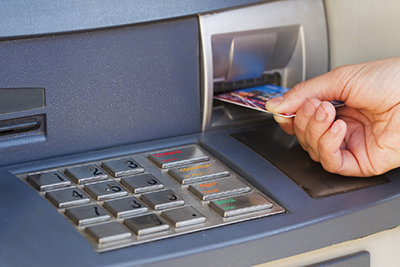Protect Your Credit Cards
Guide G-244
Revised by Bryce Jorgensen and Lauren Rodriquez
College of Agricultural, Consumer and Environmental Sciences, New Mexico State University
Authors: Respectively, Extension Family Resource Management Specialist and Research Assistant, Department of Extension Family and Consumer Sciences, New Mexico State University. (Print Friendly PDF)
Credit card fraud is a growing crime in the United States. It affects everyone—bankers, merchants, and consumers. Although consumers have some financial protection from fraudulent use, losing a credit card can be a time-consuming nuisance. Reporting the loss and getting a new card is necessary. After you report the fraudulent charges, it will take within 10 days to receive your refund.

© Tibangpain - Dreamstime.com
The growing use of automated teller machine (ATM) cards creates more problems for card users. Protections given to people who use ATM cards are quite different from credit cards, and potential losses to the card users are much greater.
Stolen credit cards have been a problem for a long time. Now that ordering merchandise through online sites is a common practice, it’s easier for thieves to install a virus on your computer and record your monetary transactions. It is vital that consumers are aware of whom they are sharing their credit card information with (e.g., account number, card number, security code), and are assured by the company with their card information that they will keep it secure.
Liability of Cardholders
Credit cards. You are liable only for the first $50 charged to your account by an unauthorized user. You do not have to pay for any unauthorized charges made after you notify the card company of loss or theft of your card. If you act quickly, you may not have any loss. Notification can be made by telephone or in writing. It is recommended that you follow up a phone call with a letter confirming your call.
If your cards have been used illegally and you have had to pay the first $50 on one or more cards, check your homeowner’s policy for reimbursement. Most policies provide coverage up to $500. No deductible applies to this coverage.
For the credit card issuer to hold you liable, they must have provided you with a telephone number, address, or both that you can use for notification. In addition, the card issuer must provide some method by which the cardholder or authorized user can be identified, such as a signature or photograph on the card.
For transactions involving only the card information and not the physical card, such as using it for phone or online purchases, you are not liable for any of the unauthorized transactions. The cardholder may not be held liable when the card itself (or some other sufficient means of identification of the cardholder) is not presented. Because the issuer has not provided a means to identify the user under these circumstances, the issuer has not fulfilled one of the conditions for imposing liability. For example, when a person orders merchandise by telephone without authority to do so and using a credit card account number, no liability may be imposed on the cardholder.
ATM cards. If your ATM card is stolen and used, your liability could be much more than the $50 limit on credit cards.
If you notify the card issuer within two days after you discover the ATM card loss, your liability cannot exceed $50. If you do not notify the financial institution within two business days after learning of a theft or loss, you can be liable for the amount taken from your account, up to a maximum of $500.
If an unauthorized transfer occurs and you do not discover it until it shows up on your monthly bank statement, you must notify the bank within 60 days after the statement was mailed to you. Your liability is $50 or the amount of the transaction, whichever is less. If you do not tell the bank within 60 days, you may be liable for all losses resulting from unauthorized use of the card after the 60-day period. This means you could lose all the money in your account.
Take Precautions With Your Credit Cards
Examine your statement. Keep your sales receipts and check your monthly statement carefully, comparing receipts with the charges on the statement. If there are charges you did not make, notify the card company immediately. Experts say that examining your statement is the single most important thing to do. Be particularly watchful when you have a big bill because of travel or holiday shopping.
Make a list. Set up a record right now of all your credit cards, the account numbers, and addresses and phone numbers of the issuing companies. Keep the list in a safe place, but not with your credit cards. This data is vital if your cards are lost or stolen. Note whether there is a toll-free number to call, or a number that can be called to collect what was lost. This information will be on the disclosure statement that comes with your new card and with each renewal card. It may also be on the back of your credit card.
Travel with care. Do not travel with more credit cards than you need for the trip. Leave the rest at home in your safe deposit box. If your cards are stolen or lost, you will need the card company’s phone number. Carry this separately from the cards.
Report the loss at once. If your cards are lost or stolen, notify the card issuer immediately. You are not liable for any charges made on your card if notification is made before the card is used.
Keep cards separate from cash. It is best not to carry your credit cards in your wallet. Use a separate cardholder or a purse that has inside zipped pockets for credit cards so you will not lose everything if your wallet is lost or stolen.
Treat cards as cash. Do not leave them lying around loose in a coat pocket, in the house, or in the glove compartment of a car. Never toss an expired card in the trash without first cutting it up. If you decide to stop using a card, notify the company to close your account. Do not lend your card to anyone.
Limit the number of cards you own. The fewer you have, the fewer you need to keep track of. Some authorities say one—or two at the most—major all-purpose cards are enough. Also limit gasoline and retail cards.
Get your card back. Be sure your card is returned after each transaction. Also, check to see that it is your card rather than a substitute card.
Watch the salesperson. Present your card only after completion of a sale. Watch how your card is handled during the transaction and see that only one slip is printed. Be sure the amount handwritten or printed on your receipt is correct.
Be cautious using your card by phone. Beware of anyone who wants you to give them your credit card number over the telephone. Counterfeiters use tricky calls to get valid numbers. Common sense will have to be your guide because there may be occasions when you must give your credit card number over the phone, such as to guarantee hotel reservations. Use your credit card number to order merchandise by phone only when necessary.
Cross-shred your receipts. Some customers tear up the receipts after a transaction so it can’t be recovered from a waste basket and used by counterfeiters or dishonest salespeople. If you take the receipt home with you, and time goes by where you no longer need it to verify your purchase to the retailer, you may shred or tear up the receipt.
Service Protection Plans
A number of companies offer a credit card listing service. For a small yearly fee, the company offers to register your credit cards, and if they are lost or stolen, they will notify all the credit card companies for you.
Before you decide to sign up for one of these plans, give some thought to whether you really need the service. Remember, federal law provides that the most you can be held liable for is $50 per card, and this is only if someone uses the card before you report the loss or theft. If you carry a large number of credit cards, this could add up if each one was used.
If you carry only a few cards, you may prefer to handle notifications yourself rather than paying the annual fee.
Protecting Your ATM/Debit Cards
A personal identification number (PIN) helps verify you’re the cardholder owner and not a thief stealing another person’s money. As technology advances, new and creative ways develop for bank theft. One increasingly common form of theft is ATM skimming/PIN capturing. This can occur with any card reader, from ATMs to stores to gas stations. A thief places a specialized device (a “skimmer”) on top of the card reader and the PIN keyboard; the skimmer looks like the real card reader, but it actually records your bank card information and your PIN. It’s important to have a designated ATM you visit so that you will be able to identify anything peculiar about the ATM. If you think the machine has been tampered with, do not insert any of your bank information and notify the bank.

© Oleg Shakirov | Dreamstime.com
There are other precautions to keep in mind with your ATM or debit card:
Memorize your PIN. Do not write it on your card. Also, do not write it on other cards in your wallet, such as your Social Security card. In an informal survey, Arizona bank officials found the PIN written on 25% of the ATM/debit cards they examined.
Choose a random number. If you choose your own PIN, stay away from your birthdate, Social Security number, address, and phone number. Thieves try these numbers first.
Check your statement. As with credit card bills, check your bank statement carefully and report any unauthorized charges immediately.
Sources
Experian. n.d. Credit card fraud: What to do if you’re a victim [Online]. Available at https://www.experian.com/blogs/ask-experian/credit-education/preventing-fraud/credit-card-fraud-what-to-do-if-you-are-a-victim/
Federal Bureau of Investigation. n.d. Credit card fraud [Online]. Available at https://www.fbi.gov/scams-and-safety/common-fraud-schemes/credit-card-fraud
Federal Trade Commission. 2012. Lost or stolen credit, ATM, and debit cards [Online]. Available at https://consumer.ftc.gov/articles/lost-or-stolen-credit-atm-debit-cards
Liability of consumer for unauthorized transfers, 12 C.F.R., Sec. 205.6, 1996.
Special credit card provisions, 12 C.F.R., Sec. 226.12, 2010.
For further reading
G-205: Don’t Be Robbed by Fraud
https://pubs.nmsu.edu/_g/G205/
G-216: You Can Check Your Credit Rating
https://pubs.nmsu.edu/_g/G216/
G-258: Managing Your Family’s Money
https://pubs.nmsu.edu/_g/G258/
Original author: Constance Kratzer, Family Resource Management Specialist.

Bryce Jorgensen is the Extension Family Resource Management Specialist at NMSU. He earned his Ph.D. at Virginia Tech. As a consultant, trainer, author, and speaker, he focuses on achieving individual, relational, and financial wellness for New Mexicans. An expert in the psychology of change, mindset, and behavioral economics, he provides customized programs leading to life and financial success.
To find more resources more resources for your business, home, or family, visit the College of Agricultural, Consumer and Environmental Sciences on the World Wide Web at pubs.nmsu.edu
Contents of publications may be freely reproduced, with an appropriate citation, for educational purposes. All other rights reserved. For permission to use publications for other purposes, contact pubs@nmsu.edu or the authors listed on the publication.
New Mexico State University is an equal opportunity/affirmative action employer and educator. NMSU and the U.S. Department of Agriculture cooperating.
Revised October 2018 Las Cruces, NM


